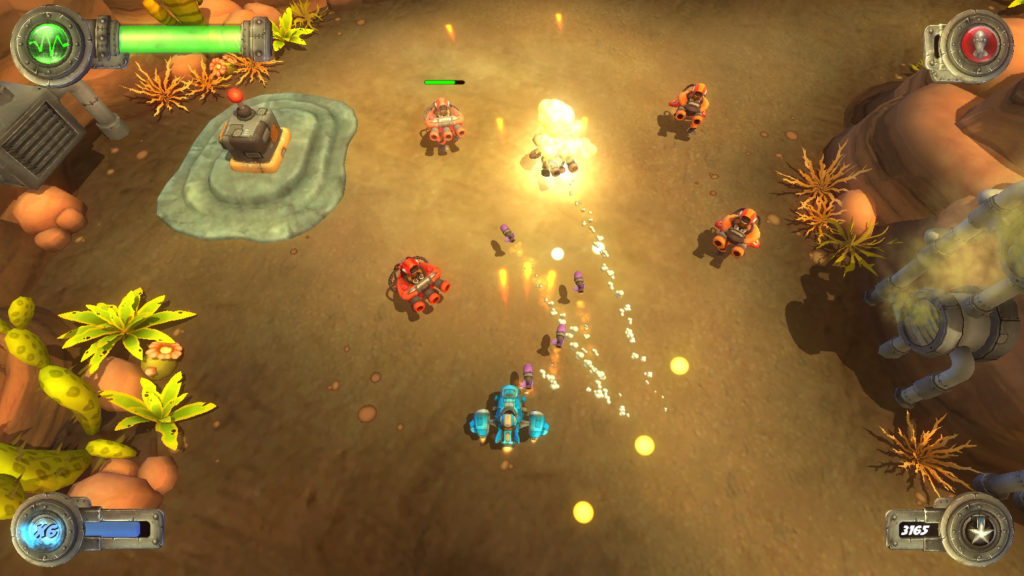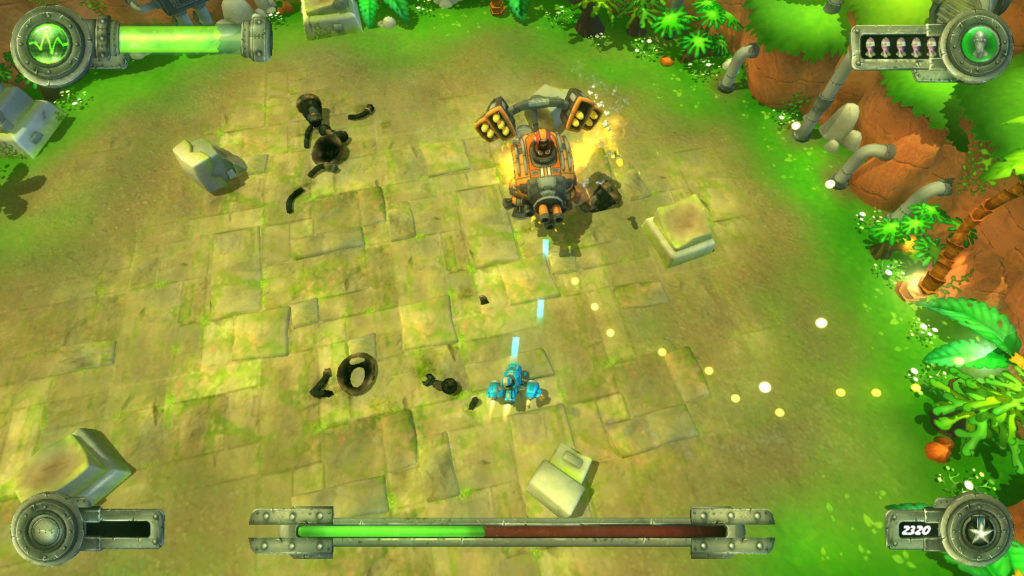First Impression articles are based entirely upon the first roughly 30 minutes of gameplay and may not necessarily be indicative of the game as a whole. This includes the score at the end.
The first three levels of Blue Rider show potential while not being overly remarkable. You’ll be disappointed if you’re hoping to see much from Blue Rider which hasn’t been done before, but this is nevertheless a decent top-down shooter which fans of the genre might want to keep their eyes on.
The most interesting part of the game is your own ship. It moves smoothly and can easily glide along at a fast pace. This smooth movement comes at a price however as you quickly build up momentum, making it difficult to stop with precision. The added momentum isn’t a flaw though, in fact I like it a lot. This gliding type of movement feels great and allows you to quickly dodge out of the way of bullets in any direction. Any precision lost when it comes to stopping is largely trivial. Furthermore, a boost button, which has a somewhat lengthy cooldown, encourages players to choose to avoid bullets by moving fast enough to get out of the way rather than by trying to stop in a safe location. As far as controls go, Blue Rider is great.
Weapons are fine enough, though they lack variety. You can have one primary weapon and one secondary weapon at any given time. To the best of my knowledge, there are only two primaries and two secondaries. Your primary weapon choices are a spread shot and a more focused shot. As for secondaries, you can choose between homing missiles and a missile barrage which shoots in front of you. The low weapon variety is counterbalanced somewhat by the massive number of times each weapon can be upgraded. Judging by the stats screen at the end of each level, primary weapons can reach level 15 while secondaries go up to 7. Picking up a capsule for a weapon you already have while waiting for a capsule to swap to the opposite color changes your weapon. The good news is that your old weapons seem to retain their previous level, or at least don’t get fully downgraded, when you swap back to them so, even though you’re probably better off choosing a specific weapon to stick with, it’s not a disaster if you swap weapons from time to time.

Upgrading weapons to ridiculous heights is satisfying. That said, the content I’ve seen has lead me to believe that the weapon choices are not strictly equal. The spread shot is great for chipping away at groups of normal enemies and it can shoot down certain enemy projectiles, like homing missiles, in the process. On the other hand, it can take a while to destroy tougher enemies and bosses take forever to go down. Two out of the three bosses I’ve seen had shielding of some sort and the third boss in particular has a small weak point which it only periodically exposes, making the spread shot agonizing to use against it. Meanwhile, the focused shot is far better for boss fights from what I’ve seen of it, though you can’t simultaneously defend and attack with it like you can the spread shot. Between the two, the focused shot feels superior, but that’s a difference which might be mended as the levels get tougher and the weapons get more fully upgraded.
Secondary weapons are another story. To put it simply, I hate the homing missiles. They home in on arbitrary targets and, more importantly, they are surprisingly bad at actually hitting. Once again, the third boss serves as a good example. This mechanical scorpion periodically shoots a container into the ground which bursts into bullets after a few seconds (or if you hit it enough). While hovering directly in front of this boss’s weak point, I launched the homing missiles and all of them swerved behind me to focus on the container rather than the closer boss; every single missile missed the immobile container. I think the tradeoff is supposed to be that the frontal barrage is less accurate as those missiles do have some horizontal deviation, but the homing attack ends up being easier to miss with!
Level design is somewhat hit and miss. The first level feels far too easy, though difficulty ramps up at a steady pace between levels and with a fairly impressive total of nine levels that leaves a lot of room for things to get really tough later on. Bosses also ramp up consistently, but it also feels like there is too much of a difficulty gap between bosses and their respective levels. Even though it makes sense for boss fights to be the most challenging parts, the amount of damage I ended up taking in boss fights far outweighed the damage I took within the levels. The end result is that even though boss fights and levels are each balanced to be harder than earlier ones, levels consistently feel a bit too easy and boss fights consistently feel a bit too tough. This isn’t a severe problem along the lines of content being outright trivial or unfair, but it’s worth noting all the same.

A bigger problem with levels is that they feel sort of bland. It’s not that the game doesn’t put effort into trying to spice things up. There are quite a few graphical assets placed about, like pipes and stone statues, which prevent the game from looking lifeless. The path isn’t an entirely linear one either. You sometimes run into barriers which need to be taken down by destroying one or more machines located elsewhere. Relics, which give you points, and treasure, which I never actually found, are scattered around the levels for players to hunt down and they’re hidden quite well too. Enemy variety in the first level didn’t impress me, but the number of enemy types grew substantially by the third level.
All that said, at the end of the day it still feels like you spend far too much time fighting in long corridors and large, vaguely circular rooms. This isn’t to say that there is a complete lack of environmental obstacles and arena variety, but there isn’t enough either. It’s also fairly easy to get turned around from time to time because even with all the little environmental touches the levels can start to look a bit samey; scorch marks from defeated enemies often acted as a better guide than environmental landmarks. I did find a temporary helper drone which followed me and shot enemies so that gives me hope for finding more interesting temporary power-ups in the future. Similarly, the game doesn’t stop you from flying off of ledges and you’ll rapidly take damage from hovering over a drop so that hints at potential for more environmental hazards. Both the drones and the ledges give me hope for more interesting design in future levels, but they are still only hints at a potential which may or may not be fully utilized.

The experience as a whole feels a bit too bare. You can adjust the resolution and the graphics quality from the options menu, but you can’t play in windowed mode. You can adjust mouse sensitivity and there’s controller support, but you can’t configure the controls. There are no volume options at all, which is a shame since the soundtrack is good and frequently gets drowned out by sound effects from explosions and bullets. Though your score is useful for earning extra lives, the game keeping track of your high score seems pointless without any sort of online leaderboard support. There’s also just not much replay value here in general since there aren’t multiple difficulties and all the secrets only seem to give you points. On the plus side, you can choose to start from any level you’ve reached and when doing so your gun doesn’t start at the weakest level.
Blue Rider seems like a fun enough way to spend an afternoon or two, but not much else. From what I’ve seen, I wouldn’t recommend buying it for its full price of $9.99, but it’s still a good top-down shooter worth considering if it goes on sale.
First Impression Verdict: Decent 3/5